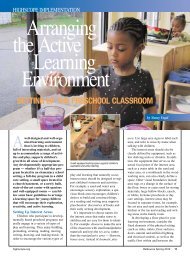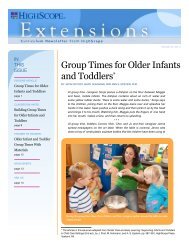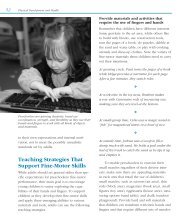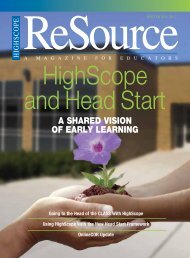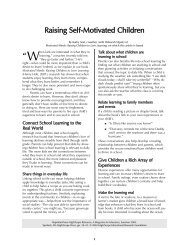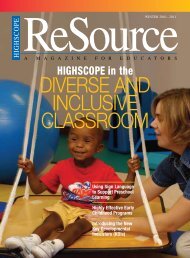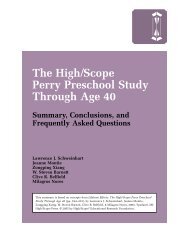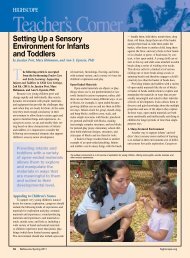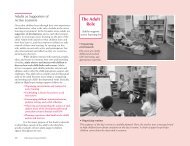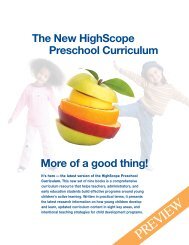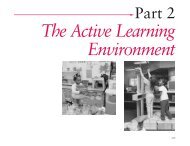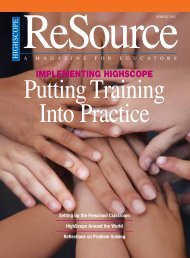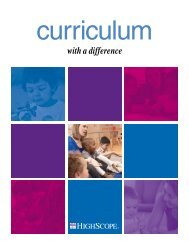Resource - High/scope In The Elementary Classroom
Resource - High/scope In The Elementary Classroom
Resource - High/scope In The Elementary Classroom
Create successful ePaper yourself
Turn your PDF publications into a flip-book with our unique Google optimized e-Paper software.
HigH/SCoPE ELEMENTARY<br />
school-age setting might also include a<br />
math area, science area, writing area,<br />
computer area, art area, bookmaking<br />
area, and quiet work area. Each area is<br />
designed around a particular curriculum<br />
topic such as reading, science, math,<br />
computer, and art. <strong>The</strong>se areas are<br />
settings designated for child-initiated<br />
learning activities.<br />
Materials<br />
in a <strong>High</strong>/Scope classroom, children<br />
have access to an abundance of meaningful<br />
materials throughout the school<br />
day. This variety and availability allows<br />
children to direct their own discoveries,<br />
and it accommodates for a variety of<br />
learning abilities.<br />
While a <strong>High</strong>/Scope elementary<br />
environment uses many of the same<br />
materials found in traditional classrooms,<br />
the use and function of these<br />
materials differs; for example, paint in<br />
a traditional classroom may be brought<br />
out at the teacher’s discretion only during<br />
specific art classes, whereas in a<br />
<strong>High</strong>/Scope classroom paint is accessible<br />
to children on a daily basis to use in<br />
self-directed ways during instructional<br />
activities. An elementary <strong>High</strong>/Scope<br />
environment also provides a variety of<br />
open-ended materials (i.e., materials<br />
that can be used in many different ways)<br />
that invite students to engage in personal,<br />
meaningful, and educational experiences.<br />
<strong>The</strong>se materials are available to children<br />
to work with throughout the day, as well<br />
as during the plan-do-review sequence.<br />
<strong>High</strong>/Scope’s <strong>Elementary</strong> Teaching Practices<br />
Daily schedule. Each day follows a consistent<br />
schedule, which is carefully planned to include<br />
individual, small-group, and large-group<br />
experiences and a balance of teacher-planned<br />
and child-planned activity. Each day includes a<br />
plan-do-review time, lasting one hour or more,<br />
in which children plan, carry out, and then reflect<br />
upon an activity of their own choosing.<br />
Small-group instructional workshops are<br />
planned by teachers around specific content in<br />
the major subject areas.<br />
<strong>The</strong> classroom. <strong>The</strong> room is divided into<br />
five or more distinct “interest” areas, such as<br />
reading and writing, math, science, art, and<br />
computers. <strong>In</strong> each area, a wide range of appealing<br />
materials are stored in consistent, accessible<br />
locations so children can get out the<br />
materials they want and put them away independently.<br />
Children are free to use any of the interest<br />
areas during plan-do-review time, and<br />
typically rotate through specific areas — such<br />
as reading and writing, art, and computers —<br />
during teacher-planned workshop times.<br />
Subject areas. Teachers plan instructional<br />
activities around content in important curriculum<br />
areas as defined by state and local standards.<br />
<strong>The</strong>y draw upon their knowledge of active learning<br />
principles and their own observations of children’s<br />
abilities and interests to plan small-group<br />
workshops focusing on concepts and skills in<br />
each subject area. <strong>The</strong> emphasis throughout<br />
these activities is on hands-on projects in which<br />
children work with manipulative materials, apply<br />
skills to solve practical problems, and learn to<br />
communicate the results of their efforts in a variety<br />
of formats. Many experiences require cooperative<br />
work and the use of effective communication<br />
skills. Teachers also encourage children<br />
to use important concepts and skills during the<br />
child-initiated activities that occur during work<br />
time and other segments of the schedule.<br />
Teacher-child interaction. <strong>High</strong>/Scope<br />
teachers avoid the use of reward and punishment<br />
to manage children’s behaviors and instead<br />
focus on creating a positive social environment<br />
in which expectations and limits are<br />
clear. Adults help children learn to use a problem-solving<br />
approach to resolve difficulties and<br />
conflicts. Adults strive to focus on children’s<br />
strengths rather than deficits and use teaching<br />
strategies that build on children’s intrinsic motivation<br />
to learn.<br />
Child assessment. <strong>High</strong>/Scope teachers<br />
document children’s progress by collecting brief<br />
anecdotal notes recording observations of children’s<br />
important behaviors and by compiling<br />
portfolios of student work samples and other<br />
kinds of documents that are evidence of children’s<br />
progress. <strong>The</strong>se assessment methods<br />
supplement traditional standardized achievement<br />
tests to provide a complete and balanced picture<br />
of children’s progress.<br />
<strong>The</strong> success of the <strong>High</strong>/Scope elementary<br />
approach has been well documented in a number<br />
of studies. Program effectiveness was initially<br />
validated in the 1980s by the U.S. Department<br />
of Education/National <strong>In</strong>stitute of Education<br />
Joint Dissemination and Review Panel. <strong>The</strong><br />
curriculum has since been revalidated by the<br />
U.S. Department of Education’s Program Effectiveness<br />
Panel. Data gathered on the approach<br />
include improvements in children’s achievement<br />
test scores and literacy skills and teacher reports<br />
of improvements in children’s abilities to<br />
solve problems, make decisions, and express<br />
themselves creatively.<br />
<strong>High</strong>/Scope’s Services and Products for <strong>Elementary</strong> Educators<br />
ready School Assessment (rSA). This tool and related training can help schools become more<br />
ready for children.<br />
<strong>Classroom</strong> practices. We provide customized training to help teachers improve classroom practices<br />
in selected areas. (Note: <strong>High</strong>/Scope does not offer specific curricula for basic academic subjects<br />
such as reading, math, and science but instead focuses on how to teach using the existing curriculum.)<br />
Movement and music. <strong>High</strong>/Scope’s Education Through Movement teaching model is the basis<br />
for a range of training services and products.<br />
www.high<strong>scope</strong>.org ReSource Fall/Winter 2008 11



